Comprehensive Financial Performance Analysis of Enero Group Limited
VerifiedAdded on 2023/01/11
|13
|2661
|63
Report
AI Summary
This report presents a financial analysis of Enero Group Limited, a telecommunications and marketing company, focusing on its financial performance and position. The analysis employs financial ratio analysis, vertical analysis, and trend analysis using data from 2017 to 2019. Key findings indicate a declining financial performance despite a strong financial position, with decreasing profitability ratios such as return on capital employed, return on equity, and net profit margin. The report assesses liquidity and efficiency ratios, revealing an adequate current ratio and asset turnover, but also highlights concerns about declining earnings per share (EPS). Vertical analysis examines the income statement and balance sheet, showing fluctuating cost of sales and administrative expenses. Horizontal analysis reveals a downward trend in revenue and significant changes in profit after tax. The report concludes by emphasizing the need for corporate restructuring and strategic management to stabilize performance and prevent further decline.
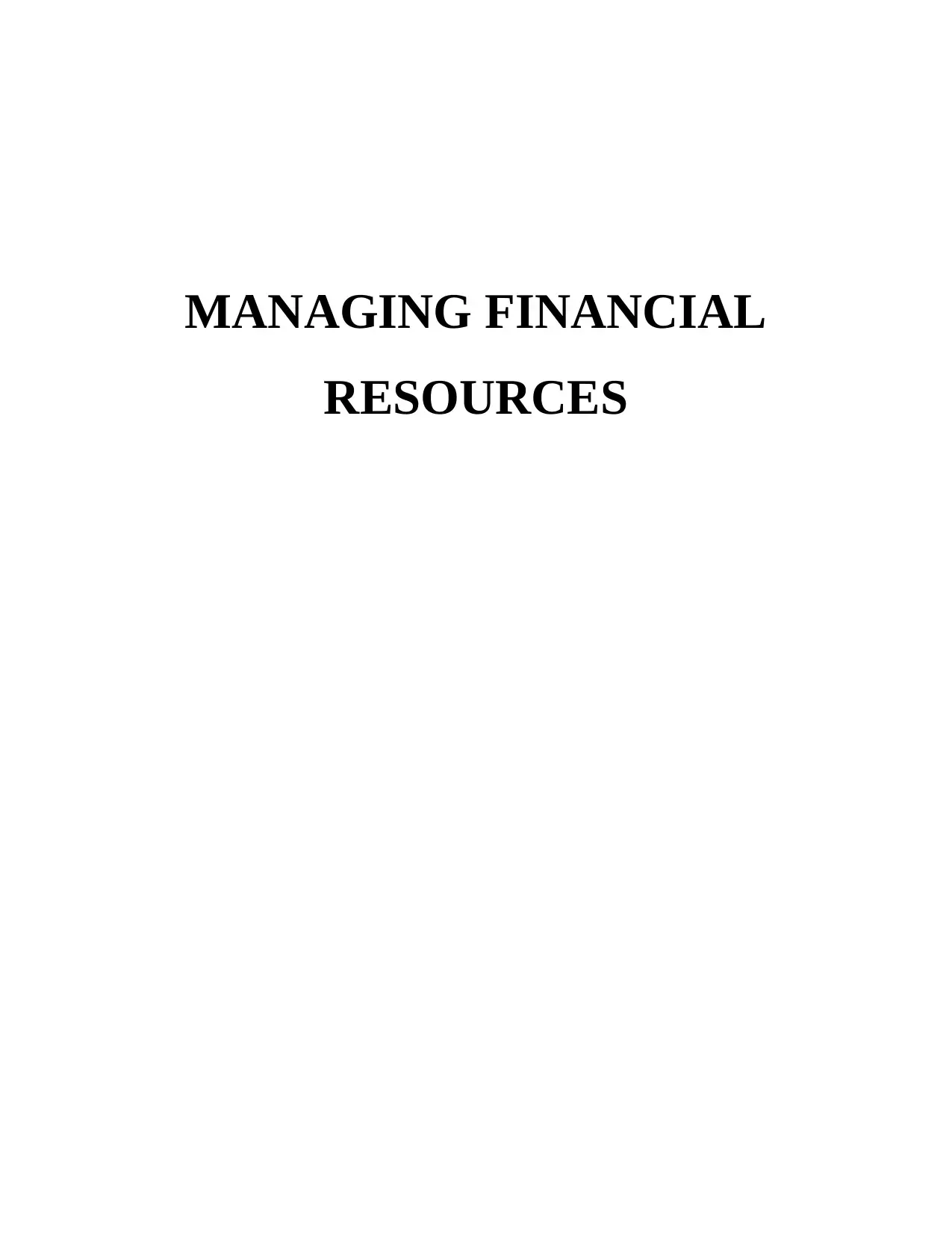
MANAGING FINANCIAL
RESOURCES
RESOURCES
Paraphrase This Document
Need a fresh take? Get an instant paraphrase of this document with our AI Paraphraser
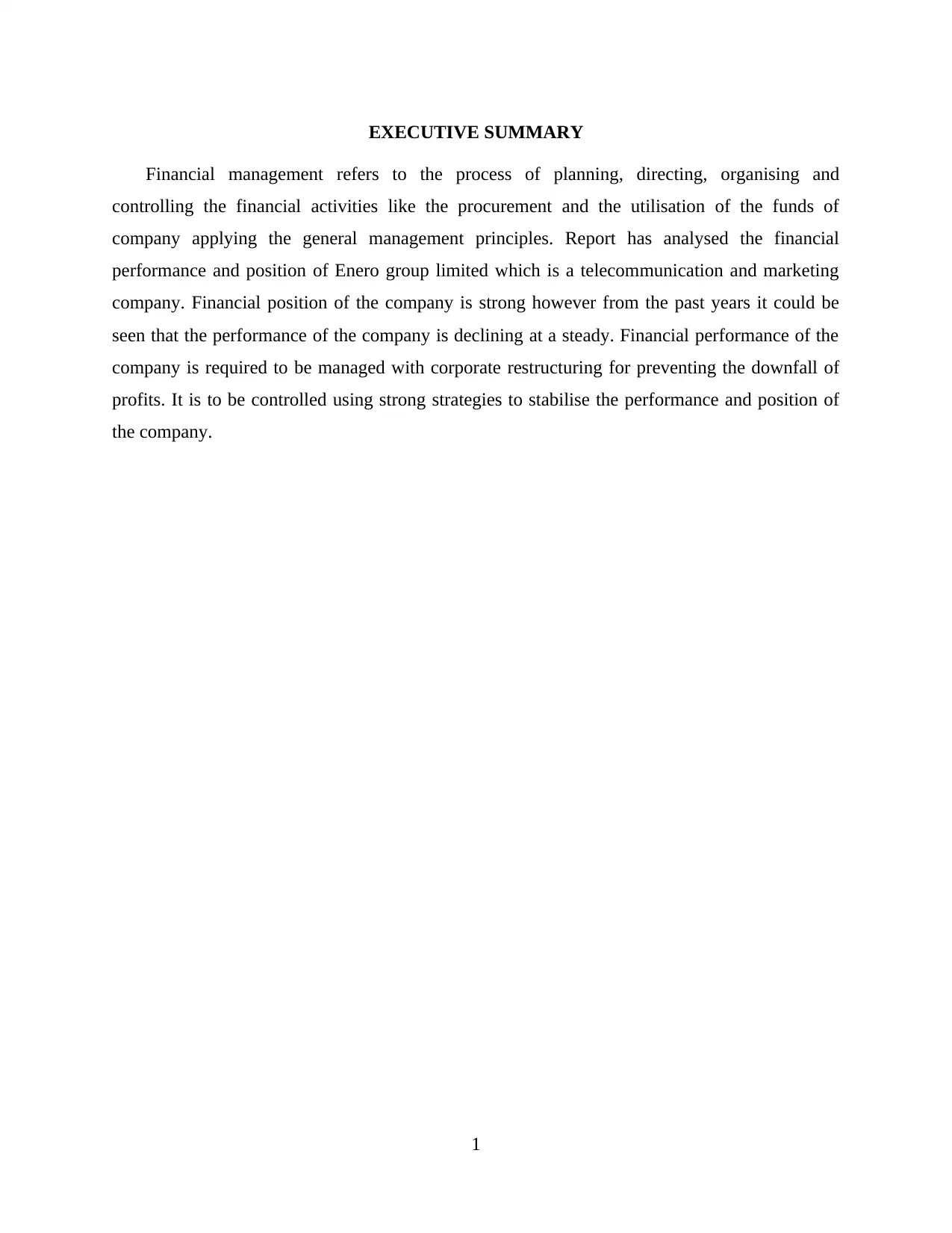
EXECUTIVE SUMMARY
Financial management refers to the process of planning, directing, organising and
controlling the financial activities like the procurement and the utilisation of the funds of
company applying the general management principles. Report has analysed the financial
performance and position of Enero group limited which is a telecommunication and marketing
company. Financial position of the company is strong however from the past years it could be
seen that the performance of the company is declining at a steady. Financial performance of the
company is required to be managed with corporate restructuring for preventing the downfall of
profits. It is to be controlled using strong strategies to stabilise the performance and position of
the company.
1
Financial management refers to the process of planning, directing, organising and
controlling the financial activities like the procurement and the utilisation of the funds of
company applying the general management principles. Report has analysed the financial
performance and position of Enero group limited which is a telecommunication and marketing
company. Financial position of the company is strong however from the past years it could be
seen that the performance of the company is declining at a steady. Financial performance of the
company is required to be managed with corporate restructuring for preventing the downfall of
profits. It is to be controlled using strong strategies to stabilise the performance and position of
the company.
1
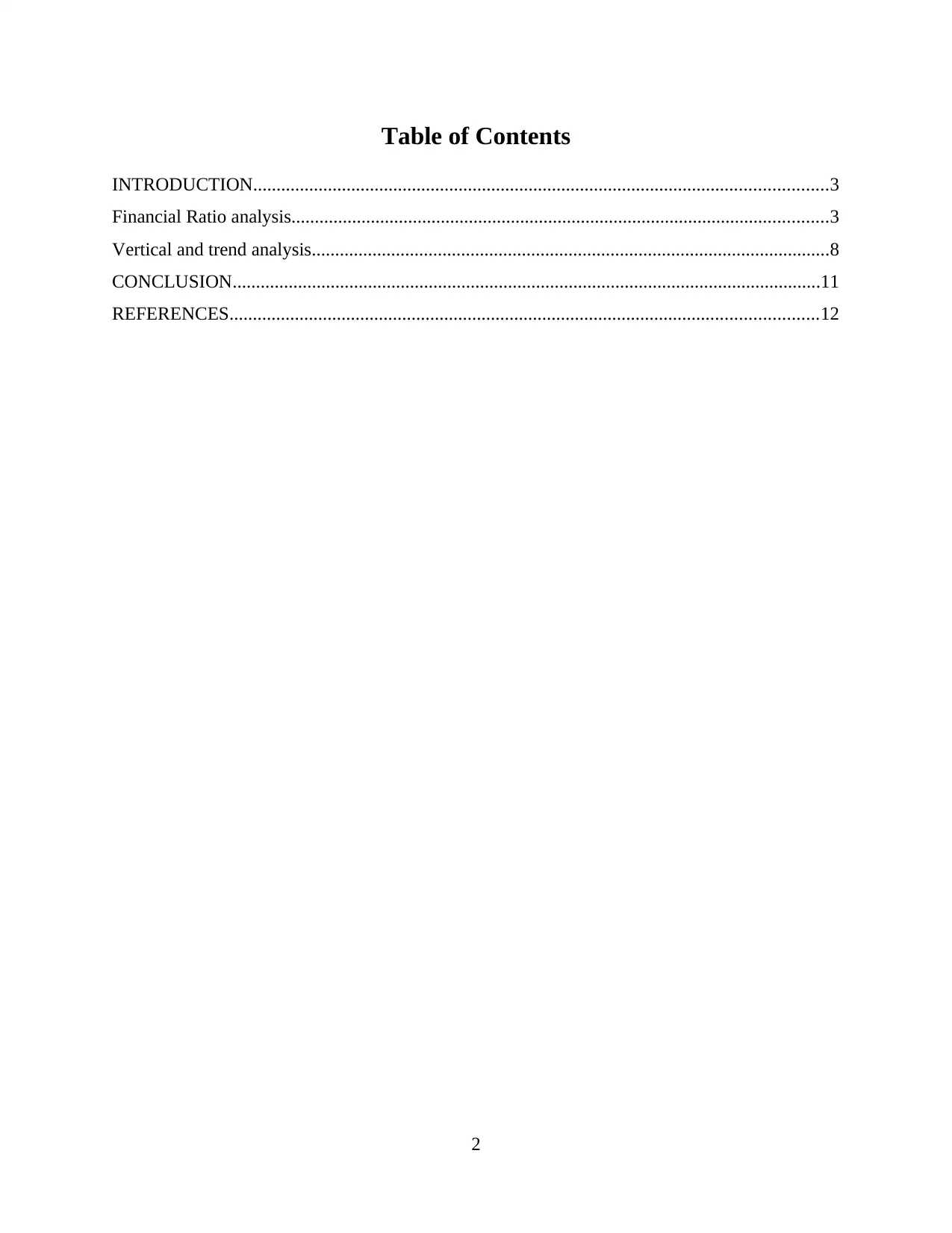
Table of Contents
INTRODUCTION...........................................................................................................................3
Financial Ratio analysis...................................................................................................................3
Vertical and trend analysis...............................................................................................................8
CONCLUSION..............................................................................................................................11
REFERENCES..............................................................................................................................12
2
INTRODUCTION...........................................................................................................................3
Financial Ratio analysis...................................................................................................................3
Vertical and trend analysis...............................................................................................................8
CONCLUSION..............................................................................................................................11
REFERENCES..............................................................................................................................12
2
⊘ This is a preview!⊘
Do you want full access?
Subscribe today to unlock all pages.

Trusted by 1+ million students worldwide
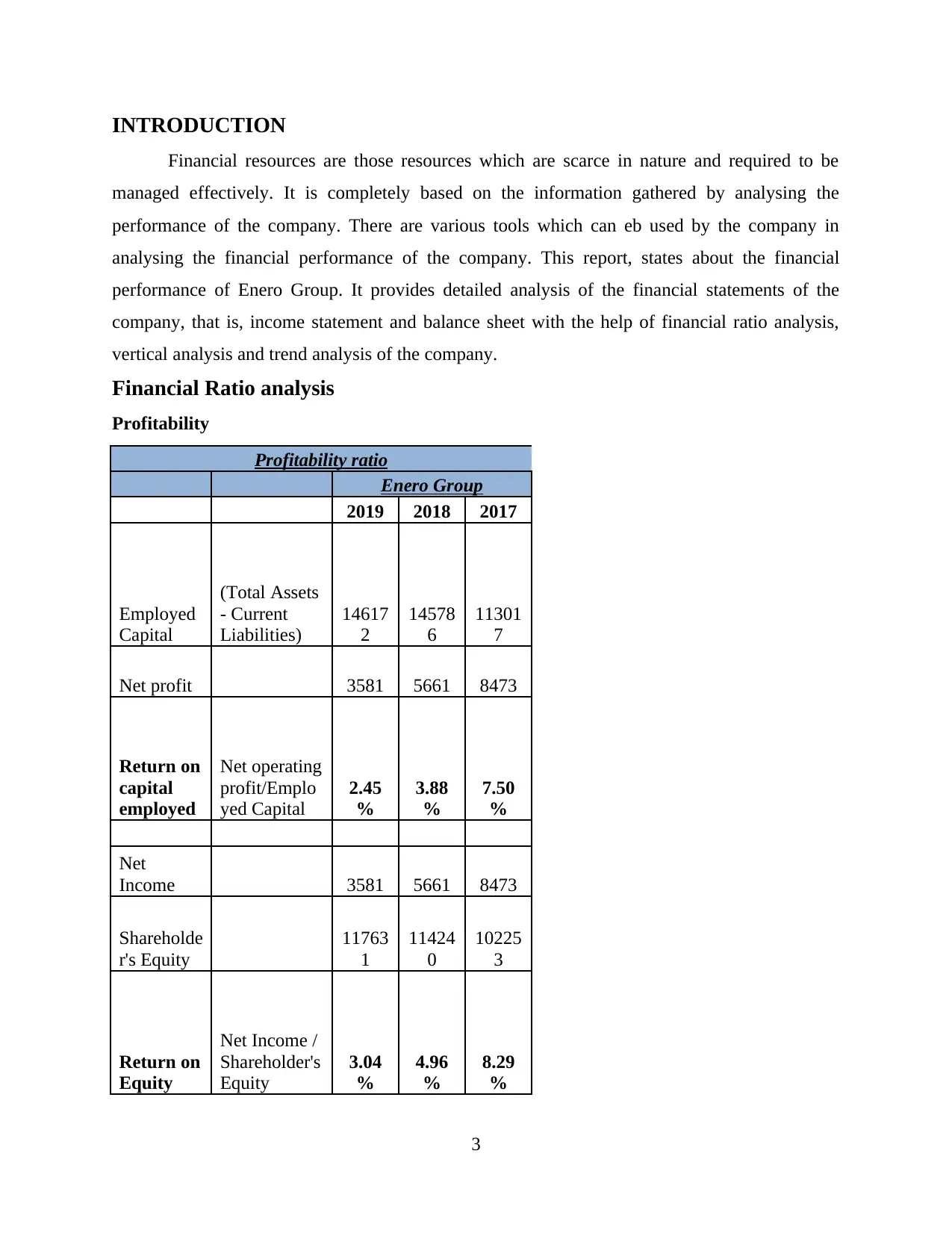
INTRODUCTION
Financial resources are those resources which are scarce in nature and required to be
managed effectively. It is completely based on the information gathered by analysing the
performance of the company. There are various tools which can eb used by the company in
analysing the financial performance of the company. This report, states about the financial
performance of Enero Group. It provides detailed analysis of the financial statements of the
company, that is, income statement and balance sheet with the help of financial ratio analysis,
vertical analysis and trend analysis of the company.
Financial Ratio analysis
Profitability
Profitability ratio
Enero Group
2019 2018 2017
Employed
Capital
(Total Assets
- Current
Liabilities)
14617
2
14578
6
11301
7
Net profit 3581 5661 8473
Return on
capital
employed
Net operating
profit/Emplo
yed Capital
2.45
%
3.88
%
7.50
%
Net
Income 3581 5661 8473
Shareholde
r's Equity
11763
1
11424
0
10225
3
Return on
Equity
Net Income /
Shareholder's
Equity
3.04
%
4.96
%
8.29
%
3
Financial resources are those resources which are scarce in nature and required to be
managed effectively. It is completely based on the information gathered by analysing the
performance of the company. There are various tools which can eb used by the company in
analysing the financial performance of the company. This report, states about the financial
performance of Enero Group. It provides detailed analysis of the financial statements of the
company, that is, income statement and balance sheet with the help of financial ratio analysis,
vertical analysis and trend analysis of the company.
Financial Ratio analysis
Profitability
Profitability ratio
Enero Group
2019 2018 2017
Employed
Capital
(Total Assets
- Current
Liabilities)
14617
2
14578
6
11301
7
Net profit 3581 5661 8473
Return on
capital
employed
Net operating
profit/Emplo
yed Capital
2.45
%
3.88
%
7.50
%
Net
Income 3581 5661 8473
Shareholde
r's Equity
11763
1
11424
0
10225
3
Return on
Equity
Net Income /
Shareholder's
Equity
3.04
%
4.96
%
8.29
%
3
Paraphrase This Document
Need a fresh take? Get an instant paraphrase of this document with our AI Paraphraser

Enero Group
2019 2018 2017
Cost of
Sales
12117
3
10049
7 96354
Sales
25502
0
23003
0
20003
9
Gross
Margin
Total Sales –
COGS/Total
Sales
52.48
%
56.31
%
51.83
%
Net profit 3581 5661 8473
Sales
25502
0
23003
0
20003
9
Net profit
ratio
Operating
Income/ Net
Sales
1.40
%
2.46
%
4.24
%
Profitability of the company is analysed using the above ratios.
Return on capital employed of the company is 2.45% that has fallen even more down.
This is used for assessing the efficiency of management to utilise the resources for generating
returns. Downfall in return is a considerable factor and makes the investors to pay attention over
the reasons.
Return on Equity shows that the business is generating enough return for its equity. It has
fallen to 3.04% from 8.29% in 2017. The significant decline shows that company is not earning
required revenues to generate adequate return to the investors (Drake, Quinn and et.al., 2017).
Return is low this have negative impact over the market performance of company.
Gross margin ratio is the amount left after carrying out the cost of sales of company.
Gross margin of the company is 52.48% that was 56.31% in 2018. Gross margin of company is
adequate however company could increase it further by ensuring more control over the cost of
sales.
4
2019 2018 2017
Cost of
Sales
12117
3
10049
7 96354
Sales
25502
0
23003
0
20003
9
Gross
Margin
Total Sales –
COGS/Total
Sales
52.48
%
56.31
%
51.83
%
Net profit 3581 5661 8473
Sales
25502
0
23003
0
20003
9
Net profit
ratio
Operating
Income/ Net
Sales
1.40
%
2.46
%
4.24
%
Profitability of the company is analysed using the above ratios.
Return on capital employed of the company is 2.45% that has fallen even more down.
This is used for assessing the efficiency of management to utilise the resources for generating
returns. Downfall in return is a considerable factor and makes the investors to pay attention over
the reasons.
Return on Equity shows that the business is generating enough return for its equity. It has
fallen to 3.04% from 8.29% in 2017. The significant decline shows that company is not earning
required revenues to generate adequate return to the investors (Drake, Quinn and et.al., 2017).
Return is low this have negative impact over the market performance of company.
Gross margin ratio is the amount left after carrying out the cost of sales of company.
Gross margin of the company is 52.48% that was 56.31% in 2018. Gross margin of company is
adequate however company could increase it further by ensuring more control over the cost of
sales.
4
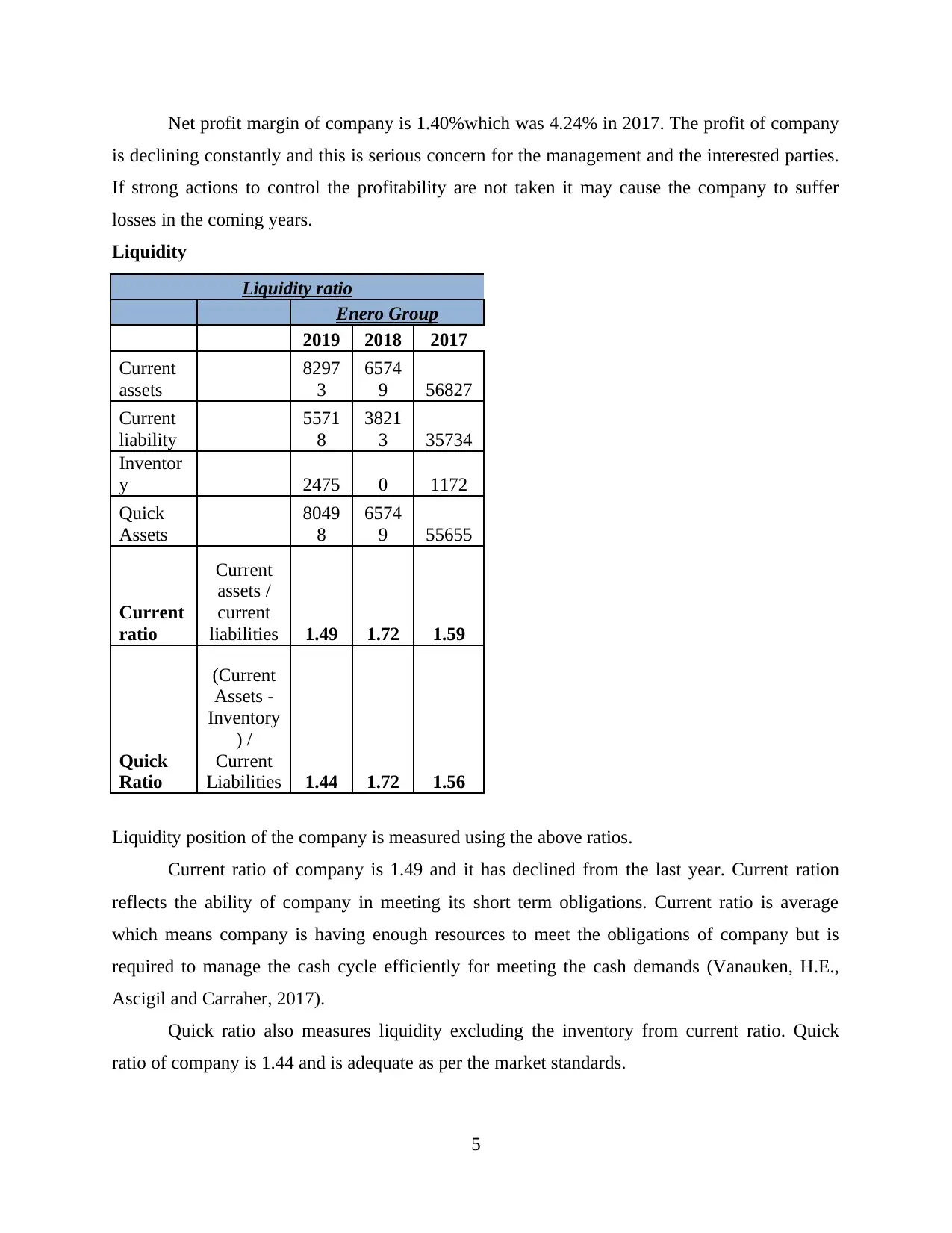
Net profit margin of company is 1.40%which was 4.24% in 2017. The profit of company
is declining constantly and this is serious concern for the management and the interested parties.
If strong actions to control the profitability are not taken it may cause the company to suffer
losses in the coming years.
Liquidity
Liquidity ratio
Enero Group
2019 2018 2017
Current
assets
8297
3
6574
9 56827
Current
liability
5571
8
3821
3 35734
Inventor
y 2475 0 1172
Quick
Assets
8049
8
6574
9 55655
Current
ratio
Current
assets /
current
liabilities 1.49 1.72 1.59
Quick
Ratio
(Current
Assets -
Inventory
) /
Current
Liabilities 1.44 1.72 1.56
Liquidity position of the company is measured using the above ratios.
Current ratio of company is 1.49 and it has declined from the last year. Current ration
reflects the ability of company in meeting its short term obligations. Current ratio is average
which means company is having enough resources to meet the obligations of company but is
required to manage the cash cycle efficiently for meeting the cash demands (Vanauken, H.E.,
Ascigil and Carraher, 2017).
Quick ratio also measures liquidity excluding the inventory from current ratio. Quick
ratio of company is 1.44 and is adequate as per the market standards.
5
is declining constantly and this is serious concern for the management and the interested parties.
If strong actions to control the profitability are not taken it may cause the company to suffer
losses in the coming years.
Liquidity
Liquidity ratio
Enero Group
2019 2018 2017
Current
assets
8297
3
6574
9 56827
Current
liability
5571
8
3821
3 35734
Inventor
y 2475 0 1172
Quick
Assets
8049
8
6574
9 55655
Current
ratio
Current
assets /
current
liabilities 1.49 1.72 1.59
Quick
Ratio
(Current
Assets -
Inventory
) /
Current
Liabilities 1.44 1.72 1.56
Liquidity position of the company is measured using the above ratios.
Current ratio of company is 1.49 and it has declined from the last year. Current ration
reflects the ability of company in meeting its short term obligations. Current ratio is average
which means company is having enough resources to meet the obligations of company but is
required to manage the cash cycle efficiently for meeting the cash demands (Vanauken, H.E.,
Ascigil and Carraher, 2017).
Quick ratio also measures liquidity excluding the inventory from current ratio. Quick
ratio of company is 1.44 and is adequate as per the market standards.
5
⊘ This is a preview!⊘
Do you want full access?
Subscribe today to unlock all pages.

Trusted by 1+ million students worldwide
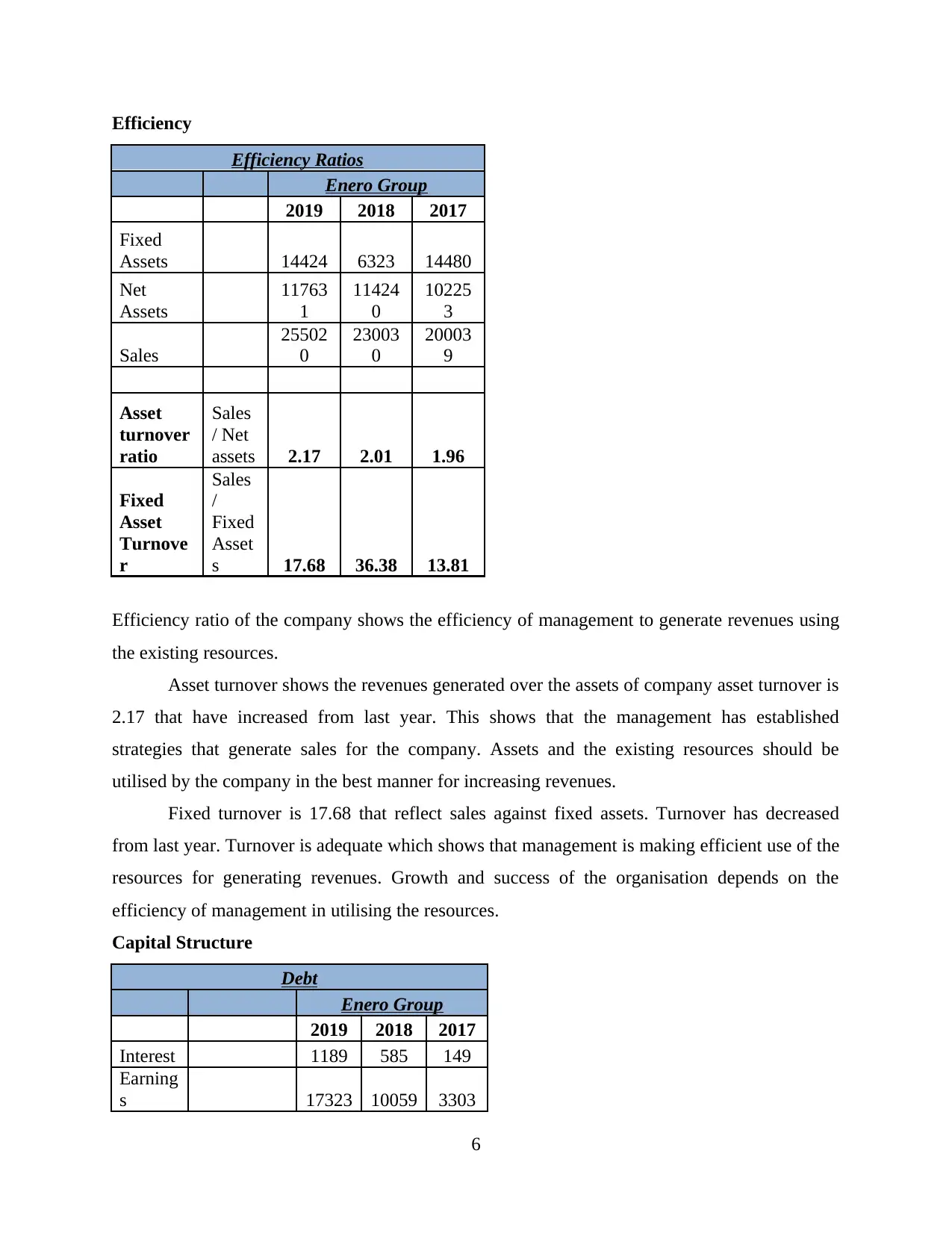
Efficiency
Efficiency Ratios
Enero Group
2019 2018 2017
Fixed
Assets 14424 6323 14480
Net
Assets
11763
1
11424
0
10225
3
Sales
25502
0
23003
0
20003
9
Asset
turnover
ratio
Sales
/ Net
assets 2.17 2.01 1.96
Fixed
Asset
Turnove
r
Sales
/
Fixed
Asset
s 17.68 36.38 13.81
Efficiency ratio of the company shows the efficiency of management to generate revenues using
the existing resources.
Asset turnover shows the revenues generated over the assets of company asset turnover is
2.17 that have increased from last year. This shows that the management has established
strategies that generate sales for the company. Assets and the existing resources should be
utilised by the company in the best manner for increasing revenues.
Fixed turnover is 17.68 that reflect sales against fixed assets. Turnover has decreased
from last year. Turnover is adequate which shows that management is making efficient use of the
resources for generating revenues. Growth and success of the organisation depends on the
efficiency of management in utilising the resources.
Capital Structure
Debt
Enero Group
2019 2018 2017
Interest 1189 585 149
Earning
s 17323 10059 3303
6
Efficiency Ratios
Enero Group
2019 2018 2017
Fixed
Assets 14424 6323 14480
Net
Assets
11763
1
11424
0
10225
3
Sales
25502
0
23003
0
20003
9
Asset
turnover
ratio
Sales
/ Net
assets 2.17 2.01 1.96
Fixed
Asset
Turnove
r
Sales
/
Fixed
Asset
s 17.68 36.38 13.81
Efficiency ratio of the company shows the efficiency of management to generate revenues using
the existing resources.
Asset turnover shows the revenues generated over the assets of company asset turnover is
2.17 that have increased from last year. This shows that the management has established
strategies that generate sales for the company. Assets and the existing resources should be
utilised by the company in the best manner for increasing revenues.
Fixed turnover is 17.68 that reflect sales against fixed assets. Turnover has decreased
from last year. Turnover is adequate which shows that management is making efficient use of the
resources for generating revenues. Growth and success of the organisation depends on the
efficiency of management in utilising the resources.
Capital Structure
Debt
Enero Group
2019 2018 2017
Interest 1189 585 149
Earning
s 17323 10059 3303
6
Paraphrase This Document
Need a fresh take? Get an instant paraphrase of this document with our AI Paraphraser

Interes
t
Covera
ge
Ratio
EBIT/
Interest 14.57 17.19 22.17
Debt 26810 30714
1006
0
Equity
11763
1
11424
0
1022
53
Debt
equity
ratio
Debt/
Equity
22.79
%
26.89
%
9.84
%
Interest coverage ratio represents the ratio of interest as against its profits. Interest on
loan cover 14% of the profit of company. at the same time it could be seen that it is decreased
from last years. Company is reducing its debt to reduce the interest costs.
Debt equity ratio is used for analysing the financial risk and capital structure of company.
Ratio of debt and equity is 22.79% with a decline from last year (Li, 2019). Company is
restructuring the capital structure by reducing debt and issuing equity funds for raising the capital
from markets. Cost of raising funds through equity is higher and also it will raise the cost of
capital of company.
Market Ratios
EPS
Enero Group
2019 2018 2017
Profit 3581 5661 8473
Number
of
shares 85605 85605 85605
EPS
EPS/
Shares 4.18 6.61 9.90
EPS shows the earnings per share of company during the year. EPS is declining
continuously from the last 3 years. This steady decline has negative impact over the market and
affects the share price of company and wealth of the shareholders. EPS of the company is
7
t
Covera
ge
Ratio
EBIT/
Interest 14.57 17.19 22.17
Debt 26810 30714
1006
0
Equity
11763
1
11424
0
1022
53
Debt
equity
ratio
Debt/
Equity
22.79
%
26.89
%
9.84
%
Interest coverage ratio represents the ratio of interest as against its profits. Interest on
loan cover 14% of the profit of company. at the same time it could be seen that it is decreased
from last years. Company is reducing its debt to reduce the interest costs.
Debt equity ratio is used for analysing the financial risk and capital structure of company.
Ratio of debt and equity is 22.79% with a decline from last year (Li, 2019). Company is
restructuring the capital structure by reducing debt and issuing equity funds for raising the capital
from markets. Cost of raising funds through equity is higher and also it will raise the cost of
capital of company.
Market Ratios
EPS
Enero Group
2019 2018 2017
Profit 3581 5661 8473
Number
of
shares 85605 85605 85605
EPS
EPS/
Shares 4.18 6.61 9.90
EPS shows the earnings per share of company during the year. EPS is declining
continuously from the last 3 years. This steady decline has negative impact over the market and
affects the share price of company and wealth of the shareholders. EPS of the company is
7
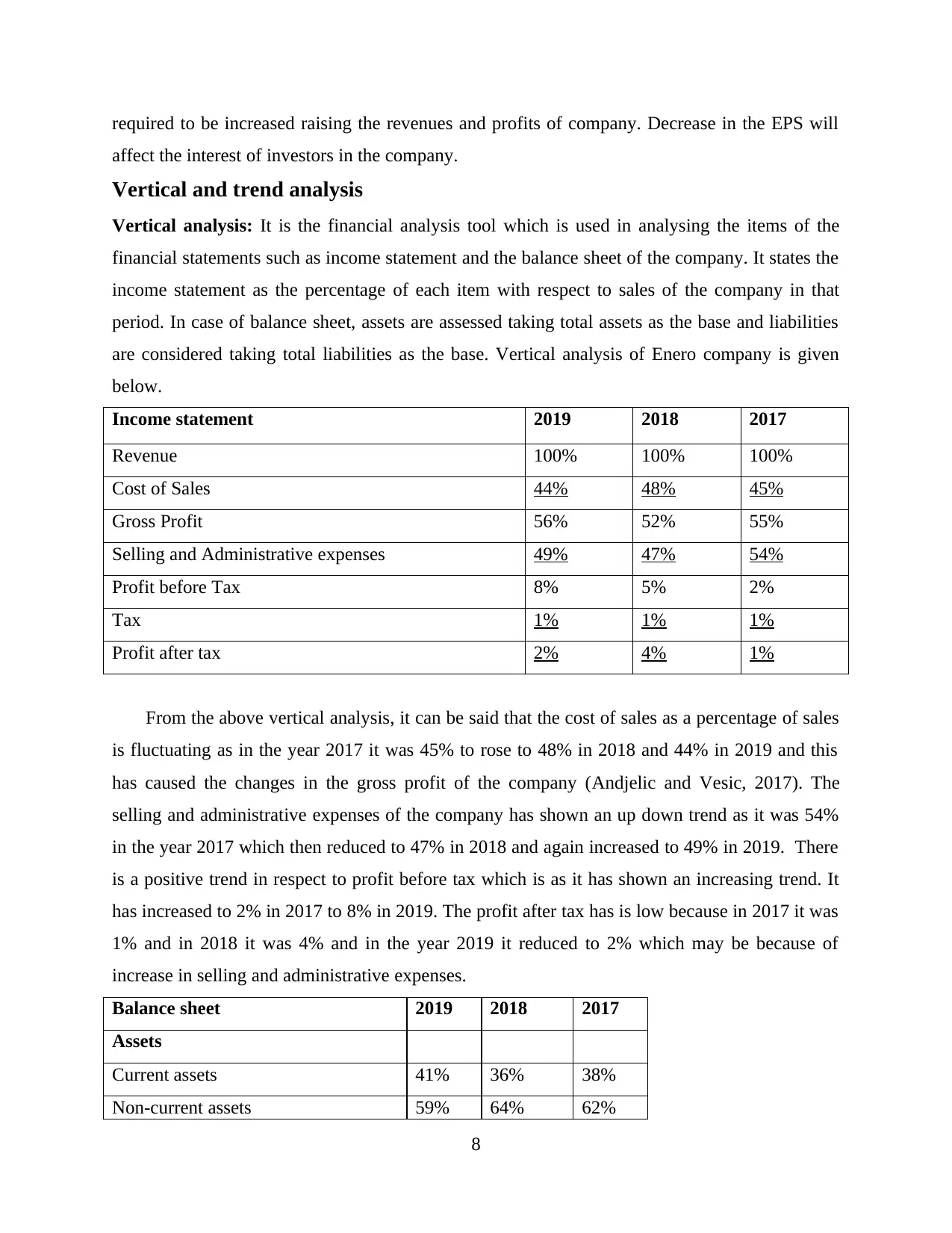
required to be increased raising the revenues and profits of company. Decrease in the EPS will
affect the interest of investors in the company.
Vertical and trend analysis
Vertical analysis: It is the financial analysis tool which is used in analysing the items of the
financial statements such as income statement and the balance sheet of the company. It states the
income statement as the percentage of each item with respect to sales of the company in that
period. In case of balance sheet, assets are assessed taking total assets as the base and liabilities
are considered taking total liabilities as the base. Vertical analysis of Enero company is given
below.
Income statement 2019 2018 2017
Revenue 100% 100% 100%
Cost of Sales 44% 48% 45%
Gross Profit 56% 52% 55%
Selling and Administrative expenses 49% 47% 54%
Profit before Tax 8% 5% 2%
Tax 1% 1% 1%
Profit after tax 2% 4% 1%
From the above vertical analysis, it can be said that the cost of sales as a percentage of sales
is fluctuating as in the year 2017 it was 45% to rose to 48% in 2018 and 44% in 2019 and this
has caused the changes in the gross profit of the company (Andjelic and Vesic, 2017). The
selling and administrative expenses of the company has shown an up down trend as it was 54%
in the year 2017 which then reduced to 47% in 2018 and again increased to 49% in 2019. There
is a positive trend in respect to profit before tax which is as it has shown an increasing trend. It
has increased to 2% in 2017 to 8% in 2019. The profit after tax has is low because in 2017 it was
1% and in 2018 it was 4% and in the year 2019 it reduced to 2% which may be because of
increase in selling and administrative expenses.
Balance sheet 2019 2018 2017
Assets
Current assets 41% 36% 38%
Non-current assets 59% 64% 62%
8
affect the interest of investors in the company.
Vertical and trend analysis
Vertical analysis: It is the financial analysis tool which is used in analysing the items of the
financial statements such as income statement and the balance sheet of the company. It states the
income statement as the percentage of each item with respect to sales of the company in that
period. In case of balance sheet, assets are assessed taking total assets as the base and liabilities
are considered taking total liabilities as the base. Vertical analysis of Enero company is given
below.
Income statement 2019 2018 2017
Revenue 100% 100% 100%
Cost of Sales 44% 48% 45%
Gross Profit 56% 52% 55%
Selling and Administrative expenses 49% 47% 54%
Profit before Tax 8% 5% 2%
Tax 1% 1% 1%
Profit after tax 2% 4% 1%
From the above vertical analysis, it can be said that the cost of sales as a percentage of sales
is fluctuating as in the year 2017 it was 45% to rose to 48% in 2018 and 44% in 2019 and this
has caused the changes in the gross profit of the company (Andjelic and Vesic, 2017). The
selling and administrative expenses of the company has shown an up down trend as it was 54%
in the year 2017 which then reduced to 47% in 2018 and again increased to 49% in 2019. There
is a positive trend in respect to profit before tax which is as it has shown an increasing trend. It
has increased to 2% in 2017 to 8% in 2019. The profit after tax has is low because in 2017 it was
1% and in 2018 it was 4% and in the year 2019 it reduced to 2% which may be because of
increase in selling and administrative expenses.
Balance sheet 2019 2018 2017
Assets
Current assets 41% 36% 38%
Non-current assets 59% 64% 62%
8
⊘ This is a preview!⊘
Do you want full access?
Subscribe today to unlock all pages.

Trusted by 1+ million students worldwide

Total assets 100% 100% 100%
Liabilities and stockholder's equity
Liabilities
Current liabilities 28% 21% 24%
Non-current liabilities 13% 17% 7%
Total liabilities 41% 37% 31%
Stockholder's equity 58% 62% 69%
Total liabilities and stockholder's
equity
100% 100% 100%
It can be seen that the current asset of the company has increased from 38% in 2017 to
41% in 2019 and the non-current assets has a been volatile as it increased in 2018 to 64% and
then reduced to 59% in the year 2019 (Xu, 2018). Like assets, the current and non-current
liabilities have shown a fluctuating trend. Also, the shareholder’s equity of the company has
reduced from 69% in 2017 to 58% in 2019.
Horizontal analysis: It involves comparing the financial ratios, benchmark or any item of the
financial statement for a specific period. It is also known as trend analysis. It allows assessment
of the relative changes in the items of revenue, expenses, assets and liabilities of the company. It
can eb performed on two more than two periods. It indicates the changing behaviour of the items
of the financial statements. Horizontal analysis of Enero company is computed below.
Income statement 2017 2018 2019
Revenue - -13.04% -21.46%
Cost of Sales - -4.12% -19.90%
Gross Profit - -19.96% -22.67%
Selling and Administrative expenses - -16.56% -13.67%
Profit before Tax - -41.93% -80.93%
Tax - -45.45% -37.70%
Profit after tax - 49.67% -68.27%
9
Liabilities and stockholder's equity
Liabilities
Current liabilities 28% 21% 24%
Non-current liabilities 13% 17% 7%
Total liabilities 41% 37% 31%
Stockholder's equity 58% 62% 69%
Total liabilities and stockholder's
equity
100% 100% 100%
It can be seen that the current asset of the company has increased from 38% in 2017 to
41% in 2019 and the non-current assets has a been volatile as it increased in 2018 to 64% and
then reduced to 59% in the year 2019 (Xu, 2018). Like assets, the current and non-current
liabilities have shown a fluctuating trend. Also, the shareholder’s equity of the company has
reduced from 69% in 2017 to 58% in 2019.
Horizontal analysis: It involves comparing the financial ratios, benchmark or any item of the
financial statement for a specific period. It is also known as trend analysis. It allows assessment
of the relative changes in the items of revenue, expenses, assets and liabilities of the company. It
can eb performed on two more than two periods. It indicates the changing behaviour of the items
of the financial statements. Horizontal analysis of Enero company is computed below.
Income statement 2017 2018 2019
Revenue - -13.04% -21.46%
Cost of Sales - -4.12% -19.90%
Gross Profit - -19.96% -22.67%
Selling and Administrative expenses - -16.56% -13.67%
Profit before Tax - -41.93% -80.93%
Tax - -45.45% -37.70%
Profit after tax - 49.67% -68.27%
9
Paraphrase This Document
Need a fresh take? Get an instant paraphrase of this document with our AI Paraphraser
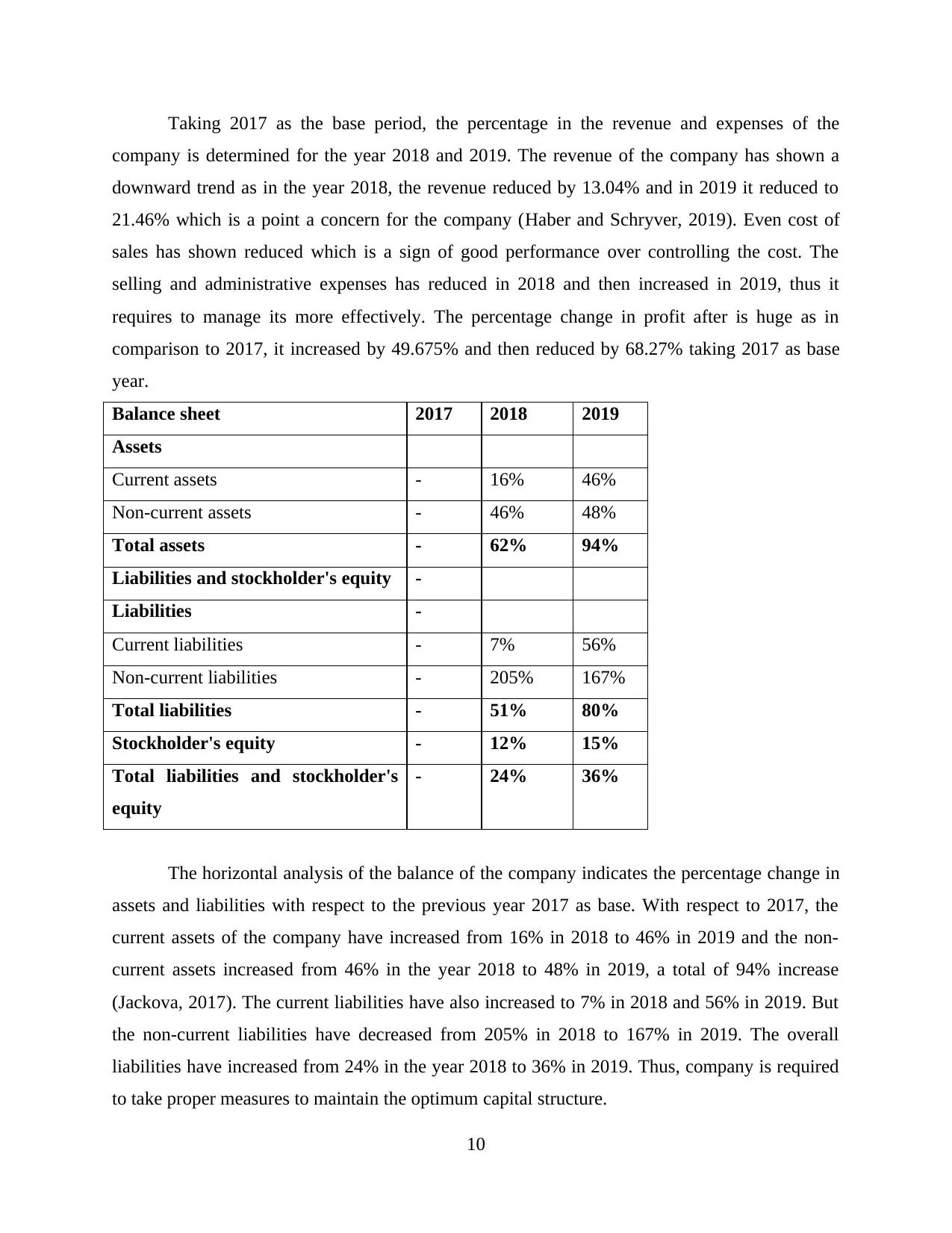
Taking 2017 as the base period, the percentage in the revenue and expenses of the
company is determined for the year 2018 and 2019. The revenue of the company has shown a
downward trend as in the year 2018, the revenue reduced by 13.04% and in 2019 it reduced to
21.46% which is a point a concern for the company (Haber and Schryver, 2019). Even cost of
sales has shown reduced which is a sign of good performance over controlling the cost. The
selling and administrative expenses has reduced in 2018 and then increased in 2019, thus it
requires to manage its more effectively. The percentage change in profit after is huge as in
comparison to 2017, it increased by 49.675% and then reduced by 68.27% taking 2017 as base
year.
Balance sheet 2017 2018 2019
Assets
Current assets - 16% 46%
Non-current assets - 46% 48%
Total assets - 62% 94%
Liabilities and stockholder's equity -
Liabilities -
Current liabilities - 7% 56%
Non-current liabilities - 205% 167%
Total liabilities - 51% 80%
Stockholder's equity - 12% 15%
Total liabilities and stockholder's
equity
- 24% 36%
The horizontal analysis of the balance of the company indicates the percentage change in
assets and liabilities with respect to the previous year 2017 as base. With respect to 2017, the
current assets of the company have increased from 16% in 2018 to 46% in 2019 and the non-
current assets increased from 46% in the year 2018 to 48% in 2019, a total of 94% increase
(Jackova, 2017). The current liabilities have also increased to 7% in 2018 and 56% in 2019. But
the non-current liabilities have decreased from 205% in 2018 to 167% in 2019. The overall
liabilities have increased from 24% in the year 2018 to 36% in 2019. Thus, company is required
to take proper measures to maintain the optimum capital structure.
10
company is determined for the year 2018 and 2019. The revenue of the company has shown a
downward trend as in the year 2018, the revenue reduced by 13.04% and in 2019 it reduced to
21.46% which is a point a concern for the company (Haber and Schryver, 2019). Even cost of
sales has shown reduced which is a sign of good performance over controlling the cost. The
selling and administrative expenses has reduced in 2018 and then increased in 2019, thus it
requires to manage its more effectively. The percentage change in profit after is huge as in
comparison to 2017, it increased by 49.675% and then reduced by 68.27% taking 2017 as base
year.
Balance sheet 2017 2018 2019
Assets
Current assets - 16% 46%
Non-current assets - 46% 48%
Total assets - 62% 94%
Liabilities and stockholder's equity -
Liabilities -
Current liabilities - 7% 56%
Non-current liabilities - 205% 167%
Total liabilities - 51% 80%
Stockholder's equity - 12% 15%
Total liabilities and stockholder's
equity
- 24% 36%
The horizontal analysis of the balance of the company indicates the percentage change in
assets and liabilities with respect to the previous year 2017 as base. With respect to 2017, the
current assets of the company have increased from 16% in 2018 to 46% in 2019 and the non-
current assets increased from 46% in the year 2018 to 48% in 2019, a total of 94% increase
(Jackova, 2017). The current liabilities have also increased to 7% in 2018 and 56% in 2019. But
the non-current liabilities have decreased from 205% in 2018 to 167% in 2019. The overall
liabilities have increased from 24% in the year 2018 to 36% in 2019. Thus, company is required
to take proper measures to maintain the optimum capital structure.
10

CONCLUSION
It can be summarized from the above that the financial statement analysis is very useful
tool in evaluating the financial performance of the company. It provides information from the
various aspects of the company in terms of liquidity, efficiency, profitability, solvency etc.
Along with the ratio analysis, vertical analysis and trend analysis is also very important in
determining the proportion and trend of change in the revenue and expenses and assets and
liabilities of the company. The company mainly requires to focus on its debt equity ratio which is
very high and requires to be manage the solvency of the company Enero Group and mainly
focussing on the it non-current liabilities. The information gathered through this helps in taking
crucial business decisions for long term success of the organization.
11
It can be summarized from the above that the financial statement analysis is very useful
tool in evaluating the financial performance of the company. It provides information from the
various aspects of the company in terms of liquidity, efficiency, profitability, solvency etc.
Along with the ratio analysis, vertical analysis and trend analysis is also very important in
determining the proportion and trend of change in the revenue and expenses and assets and
liabilities of the company. The company mainly requires to focus on its debt equity ratio which is
very high and requires to be manage the solvency of the company Enero Group and mainly
focussing on the it non-current liabilities. The information gathered through this helps in taking
crucial business decisions for long term success of the organization.
11
⊘ This is a preview!⊘
Do you want full access?
Subscribe today to unlock all pages.

Trusted by 1+ million students worldwide
1 out of 13
Related Documents
Your All-in-One AI-Powered Toolkit for Academic Success.
+13062052269
info@desklib.com
Available 24*7 on WhatsApp / Email
![[object Object]](/_next/static/media/star-bottom.7253800d.svg)
Unlock your academic potential
Copyright © 2020–2025 A2Z Services. All Rights Reserved. Developed and managed by ZUCOL.





